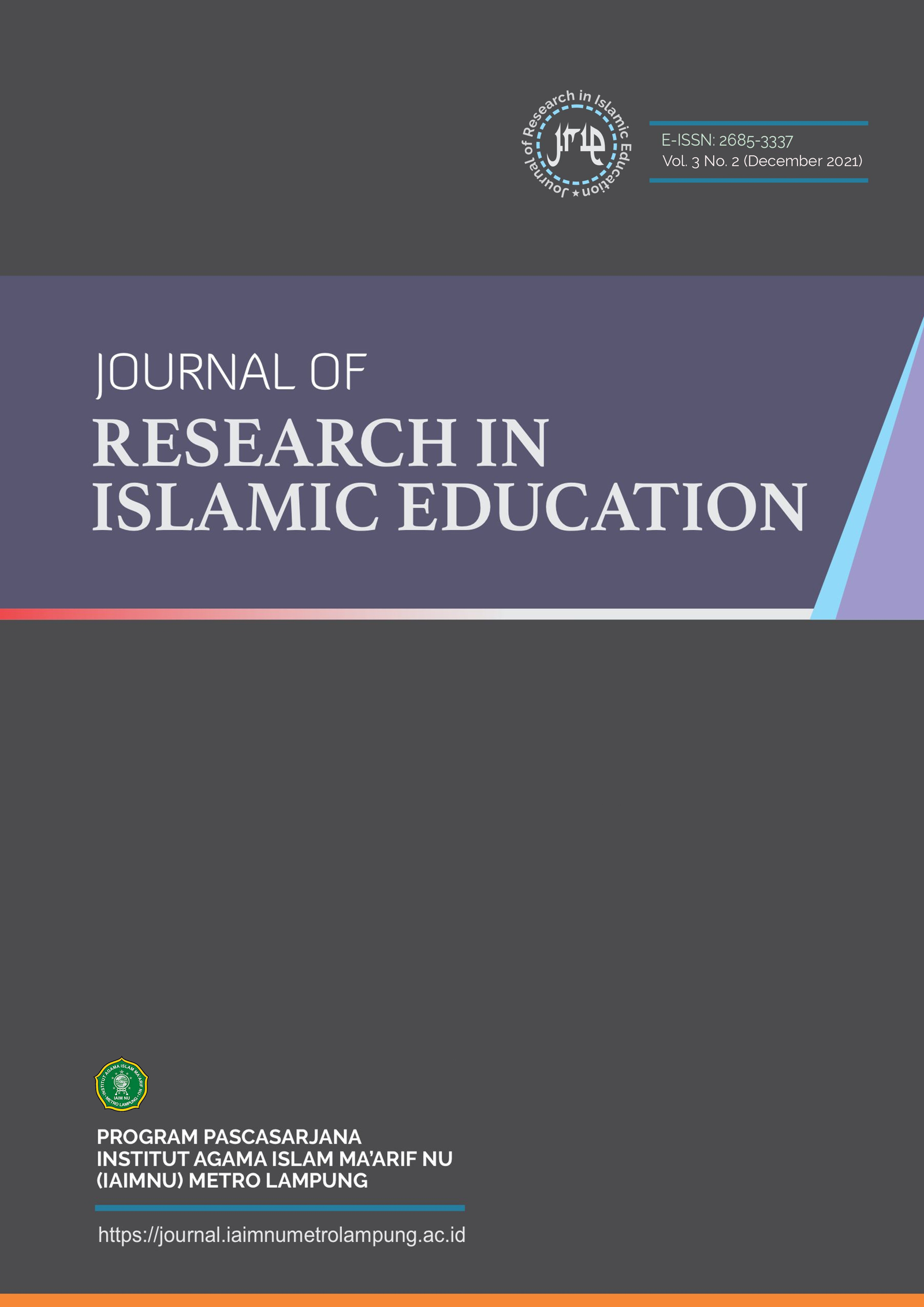Developing Islamic Education and Character Based Learning Models Based on Emotional Intelligence to Improve Morality of Students at Budi Utomo Vocational School (SMK)Way Jepara
DOI:
https://doi.org/10.25217/jrie.v4i1.1754Keywords:
Character based Learning , Model, Emotional Intelligence, Islamic Religious EducationAbstract
According to government regulations, Islamic Religious Education (PAI) and Budi Pekerti subjects in SMK are given the task of producing students who are pious and have noble character. However, in practice, learning PAI and Budi Pekerti at SMK Budi Utomo Way Jepara tends to focus on increasing knowledge. This condition is exacerbated by the presence of some students who practice despicable morals. Therefore, a PAI and Budi Pekerti learning model is needed which is oriented towards fostering students' morals. The PAI and Budi Pekerti learning model based on emotional intelligence is seen as a solution, because this intelligence leads to moral development. The learning model is assessed from the aspects of validity, practicality and effectiveness. To achieve this goal, the Plomp model development research was used, which consisted of five phases, namely: 1) initial investigation, 2) design, 3) realization/construction. 4) test, evaluation and revision, and 5) implementation. The trial was carried out using a pretest-posttest pre-experimental design in eight classes of class XI students in the odd semesterof2021/2022.Datacollected through interviews, observations, questionnaires/questionnaires, reflection sheets and action plans were analyzed using descriptive analysis, Kolmogorov-Smirnov and paired T-test. The results showed that 1) the learning model got a very valid score with an average value of 94.53 which means it is very valid, can be used without revision 2) the learning model is considered very practical with an average value of 95.83 which means it is very practical, can be used without revision, and 3) the learning model is considered very good and can improve morals. Thus the learning model can be used to foster the morals of students at Budi Utomo Way Jepara Vocational School, as well as an effective learning model or able to improve students' morals (attitudes) towards Respect and Obedience to Parents and teacher.
References
Abdullah, M. A. (1998). Problem Epistemologis-Metodologis Pendidikan Islam. Pustaka Pelajar. Azis Q, I., & Anzumi, N. (2019). Teacher and Student Ethic Concept: A Study Toward the
Abrori, M Sayyidul, and Moh. Solikul Hadi, ‘Integral Values in Madrasah: To Foster Community Trust in Education’, Istawa : Jurnal Pendidikan Islam, 5.2 (2020), 160 <https://doi.org/10.24269/ijpi.v5i2.2736>
Anjas Pratiwi, and M. Solikul Hadi, ‘The Urgence of Siti Bariyah’s Thinking in Islamic Education 5.0’, Journal of Contemporary Islamic Education, 2.2 (2022), 147–65 <https://doi.org/10.25217/jcie.v2i2.2579>
Balitbang, P. (2003). Standar Kompetensi Mata pelajaran pendidikan Agama Islam SMP dan MTs.
Camras, L. A., & Witherington, D. C. (2005). Dynamical systems approaches to emotional development. Developmental Review, 25(3-4), 328-350. https://doi.org/10.1016/j.dr.2005.10.002
Fuad, N. M. (2017). Pengaruh Model Pembelajaran Differentiated Science Inquiry dipadu Mind Mapping terhadap Hasil Belajar Kognitif IPA-Biologi, Ketrampilan Berpikir Kritis dan Kreatif Ditinjau dari Gender pada Siswa SMP Negeri di Kabupaten Kediri [Disertasi]. Universitas Negeri Malang. https://doi.org/10.35580/cse.v3i1.52451
Goleman, D. (1999a). Emotional Intelligence, Kecerdasan Emosional: Mengapa EI Lebih Penting dari pada IQ terj. T. Hernaya dalam “Achmad Sultoni_F530115022.pdf.” Gramedia Pustaka Utama. https://doi.org/10.25217/jrie.v4i1.1754
Goleman, D. (1999b). Kecerdasan Emosi untuk Mencapai Puncak Prestasi, terj. A;ex Tri Kantjono Widodo dalam “Achmad Sultoni_F530115022.pdf.” Gramedia Pustaka Utama. https://doi.org/10.25217/jrie.v4i1.1754
Hadi, Moh. Solikul, M. Sayyidul Abrori, and Dwi Noviatul Zahra, ‘Pengembangan Multimedia Interaktif Macromedia Flash Profesional 8 Pada Pembelajaran Al-Qur’an Hadis Kelas X Semester Genap Di Man 1 Yogyakarta’, At-Tajdid : Jurnal Pendidikan Dan Pemikiran Islam, 3.2 (2020), 148 <https://doi.org/10.24127/att.v3i2.1123>
Hanbal, A. (1999). Musnad Al Imam Ahmad bin Hanbal, Juz XIV dalam “Achmad Sultoni_F530115022.pdf,” t.t. Muassasah al-Risalah. https://doi.org/10.25217/jrie.v4i1.1754
Haryati, N. (2011). Pengembangan Kurikulum Pendidikan Agama Islam. Alfabeta.
Miles, M. B., Huberman, A. M., & Saldana, J. (2014). Qualitative Data Analysis: A Methods Sourcebook, edisi 3. Sage Publication Inc. https://books.google.co.id/books?id=p0wXBAAAQBAJ&printsec=frontcover&hl=id&source=gbs_vpt_read#v=onepage&q&f=false
Moh. Solikul Hadi, Dkk, ‘Efektifitas Instrumen Penilaian Pendidikan Agama Islam Untuk Meningkatkan Kemampuan Berpikir Kritis Dan Kreatif Peserta Didik Di Smk Muhammadiyah Mlati Yogyakarta’, Berkala Ilmiah Pendidikan, 4.1 (2024), 28–34 https://doi.org/10.51214/bip.v2i2.427
Moh. Solikul Hadi, Muhammad Nuril Anam, M. Sayyidul Abrori, ‘Reconstruction Of Martin Heiddeger’s Thinking Existentialism Model on Education InThe Industrial Era 4.0’, Journal of Research in Islamic Education, 03.02 (2021), 47–58. https://doi.org/10.25217/jrie.v3i2.2029
Muhaimin, et.al. (2002). Paradigma Pendidikan Islam. PT. Rosdakarya.
Peraturan Pemerintah Republik Indonesia tentang Pendidikan Agama dan Pendidikan Keagamaan., 55 (2007). https://publikasiilmiah.ums.ac.id/bitstream/handle/11617/10586/Prosiding%20Seminar%20Al-Islam%20%26%20Kemuhammadiyahan_02.pdf?sequence=1&isAllowed=y#:~:text=Peraturan%20Pemerintah%20Nomor%2055%20tahun,jenis%2C%20dan%20jenjang%20pendidikan%20wajib
Thought of K.H. Hasyim Asy’ari. Journal of Research in Islamic Education, 1(1). https://doi.org/10.25217/jrie.v1i1.422
Zahro, M. (2018, Januari 2). Wawancara dengan Maslihatuz Zahro sebagai salah satu Guru PAI di SMK Budi Utomo Way Jepara [Komunikasi pribadi]. https://doi.org/10.25217/jrie.v4i1.1754
Downloads
Published
How to Cite
Issue
Section
License
Copyright (c) 2022 Journal of Research in Islamic Education

This work is licensed under a Creative Commons Attribution-ShareAlike 4.0 International License.




